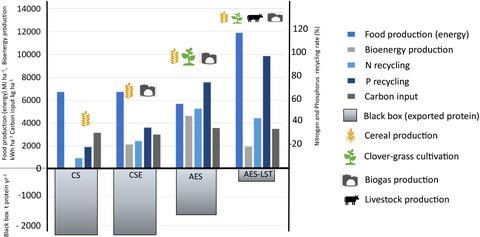当前位置:
X-MOL 学术
›
Food Energy Secur.
›
论文详情
Our official English website, www.x-mol.net, welcomes your feedback! (Note: you will need to create a separate account there.)
Smart integration of food and bioenergy production delivers on multiple ecosystem services
Food and Energy Security ( IF 5 ) Pub Date : 2021-02-18 , DOI: 10.1002/fes3.279 Kari Koppelmäki 1, 2, 3 , Marjukka Lamminen 2, 4 , Juha Helenius 2, 3, 4 , Rogier P. O. Schulte 1
Food and Energy Security ( IF 5 ) Pub Date : 2021-02-18 , DOI: 10.1002/fes3.279 Kari Koppelmäki 1, 2, 3 , Marjukka Lamminen 2, 4 , Juha Helenius 2, 3, 4 , Rogier P. O. Schulte 1
Affiliation

|
Agriculture is expected to feed an increasing global population while at the same time meeting demands for renewable energy and the supply of ecosystem services such as provision of nutrient cycling and carbon sequestration. However, the current structure of the agricultural system works against meeting these expectations. The spatial separation of crop and livestock farms has created negative environmental consequences, and bioenergy production has created a trade‐off between food and energy production. In this paper, we explore the opportunities for ecological intensification at a regional scale made possible by combining food and energy production. We built three scenarios representing farming systems including biogas production using grass biomass and manure. These scenarios included the following: (a) The current system with energy production (CSE) from non‐edible agricultural biomasses (CSE). (b) Agroecological symbiosis (AES) identical to CSE except with 20% of the arable cropping area converted to clover‐grasses for use in biogas production. (c) Agroecological symbiosis with livestock (AES‐LST) where the available grass biomass (20% as in the AES) is fed to livestock and manure then used as a feedstock in biogas production. In each scenario, nutrients were circulated back to crops in the form of digestate. The supply of soil functions (primary production for food and energy, provision of nutrient cycling, and climate mitigation) and impacts on water quality through nutrient losses in these three scenarios were then compared to the current system. Integrating biogas production into food production resulted in an increased supply of nutrient recycling, reduced nutrient losses, and increased carbon inputs to the soils indicating enhanced climate mitigation. Food production was either not affected (CSE), increased (AES‐LST), or decreased (AES), and biogas was produced in substantial quantities in each scenario. Our study demonstrated potential synergies in integrating food and energy production without compromising other ecosystem services in each scenario.
中文翻译:

粮食和生物能源生产的智能整合可提供多种生态系统服务
预计农业将满足不断增长的全球人口需求,同时满足对可再生能源和生态系统服务的需求,例如提供养分循环和固碳。但是,当前的农业体系结构与实现这些期望背道而驰。农作物和牲畜农场的空间分隔造成了负面的环境影响,而生物能源的生产已在粮食和能源的生产之间进行了权衡。在本文中,我们探索了通过粮食与能源生产相结合而在区域规模上进行生态集约化的机会。我们建立了三种代表农业系统的方案,包括使用草类生物质和肥料生产沼气。这些方案包括以下内容:(a)当前具有非食用农业生物质(CSE)能源生产(CSE)的系统。(b)农业生态共生(AES)与CSE相同,只是将耕作面积的20%转化为三叶草用于沼气生产。(c)与牲畜的农业生态共生(AES-LST),将可用的草类生物量(按AES的20%)饲喂给牲畜和粪便,然后用作沼气生产的原料。在每种情况下,营养素都以消化液的形式循环回农作物。然后将这三种情况下土壤功能的供给(主要用于粮食和能源生产,提供养分循环和缓解气候变化)以及通过养分流失对水质的影响。将沼气生产整合到粮食生产中可以增加养分循环利用的供给,减少养分流失,并增加土壤的碳输入量,这表明气候缓解措施得到了加强。粮食生产未受到影响(CSE),增加(AES-LST)或减少(AES),并且在每种情况下都大量生产沼气。我们的研究表明,在每种情况下,在不损害其他生态系统服务的前提下,整合粮食和能源生产的潜在协同作用。
更新日期:2021-02-18
中文翻译:

粮食和生物能源生产的智能整合可提供多种生态系统服务
预计农业将满足不断增长的全球人口需求,同时满足对可再生能源和生态系统服务的需求,例如提供养分循环和固碳。但是,当前的农业体系结构与实现这些期望背道而驰。农作物和牲畜农场的空间分隔造成了负面的环境影响,而生物能源的生产已在粮食和能源的生产之间进行了权衡。在本文中,我们探索了通过粮食与能源生产相结合而在区域规模上进行生态集约化的机会。我们建立了三种代表农业系统的方案,包括使用草类生物质和肥料生产沼气。这些方案包括以下内容:(a)当前具有非食用农业生物质(CSE)能源生产(CSE)的系统。(b)农业生态共生(AES)与CSE相同,只是将耕作面积的20%转化为三叶草用于沼气生产。(c)与牲畜的农业生态共生(AES-LST),将可用的草类生物量(按AES的20%)饲喂给牲畜和粪便,然后用作沼气生产的原料。在每种情况下,营养素都以消化液的形式循环回农作物。然后将这三种情况下土壤功能的供给(主要用于粮食和能源生产,提供养分循环和缓解气候变化)以及通过养分流失对水质的影响。将沼气生产整合到粮食生产中可以增加养分循环利用的供给,减少养分流失,并增加土壤的碳输入量,这表明气候缓解措施得到了加强。粮食生产未受到影响(CSE),增加(AES-LST)或减少(AES),并且在每种情况下都大量生产沼气。我们的研究表明,在每种情况下,在不损害其他生态系统服务的前提下,整合粮食和能源生产的潜在协同作用。


























 京公网安备 11010802027423号
京公网安备 11010802027423号